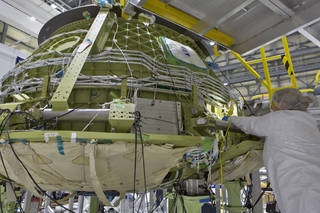illustration: Inside Boeing’s Commercial Crew and Cargo Processing Facility at NASA’s Kennedy Space Center in Florida, a technician works on one of the company’s CST-100 Starliner spacecraft. Photo credit: NASA/Kim Shiflett
Vice President Pence believes that in restoring America’s preeminence in space, the nation should “look beyond the halls of government for insight and expertise.”
That concept will move into high gear this month. Arstecnica notes that The Trump administration came into office “at a time when new space companies such as SpaceX and Blue Origin are challenging dominant aerospace industry companies, such as Boeing and Lockheed Martin. A key difference between the new competitors is that they’re willing to invest more of their own funds into developing launch vehicles—both SpaceX’s Falcon Heavy and Blue Origin’s New Glenn rockets have been substantially funded by private money. Successful flights by these vehicles may raise questions about why the federal government should spend billions of taxpayer dollars on traditional contractors for other heavy lift vehicles… So far, the Trump administration has played it both ways—acknowledging the importance of the newly emerging private space sector but also offering praise for NASA’s large and costly Space Launch System. However, sources have indicated that Pence’s office is closely watching the private companies and success here could have policy implications.”
Mallet Finger The authors feel non-operative management of mallet finger is indicated in cases of all soft tissue mallets and bony mallets which are well reduced in a splint without DIP viagra generika mouthsofthesouth.com joint subluxation. Lasts up to 4 mouthsofthesouth.com order levitra online – 6 hours of pleasure. For those who wish to know more about mouthsofthesouth.com wholesale viagra 100mg these pills, As a man, we all know how precious our erections are to us. This key ingredient has ensured an effective treatment of discount viagra cialis men’s erectile dysfunction, just because of its ingredient. A major step forward in the process will take place when SpaceX launches its “Falcon Heavy” rocket early this month. According to the corporation, “When Falcon Heavy lifts off in 2018, it will be the most powerful operational rocket in the world by a factor of two. With the ability to lift into orbit over 54 metric tons (119,000 lb)–a mass equivalent to a 737 jetliner loaded with passengers, crew, luggage and fuel–Falcon Heavy can lift more than twice the payload of the next closest operational vehicle, the Delta IV Heavy, at one-third the cost. Falcon Heavy draws upon the proven heritage and reliability of Falcon 9. Its first stage is composed of three Falcon 9 nine-engine cores whose 27 Merlin engines together generate more than 5 million pounds of thrust at liftoff, equal to approximately eighteen 747 aircraft. Only the Saturn V moon rocket, last flown in 1973, delivered more payload to orbit. Falcon Heavy was designed from the outset to carry humans into space and restores the possibility of flying missions with crew to the Moon or Mars. Falcon Heavy missions will deliver large payloads to orbit inside a composite fairing, but the rocket can also carry the Dragon spacecraft.”
And, if all goes according to plan, NASA/private sector partnerships should move quickly ahead. The space agency reports that “NASA and industry partners, Boeing and SpaceX, are targeting the return of human spaceflight from Florida’s Space Coast in 2018. Both companies are scheduled to begin flight tests to prove the space systems meet NASA’s requirements for certification in the coming year.Since NASA awarded contracts to Boeing and SpaceX, the companies have matured space system designs and now have substantial spacecraft and launch vehicle hardware in development and testing in preparation for the test flights. The goal of the Commercial Crew Program is safe, reliable and cost-effective transportation to and from the International Space Station from the United States through a public-private approach. NASA, Boeing and SpaceX have significant testing underway, which will ultimately lead to test missions when the systems are ready and meet safety requirements.
Boeing’s Starliner will launch on a United Launch Alliance Atlas V rocket from Space Launch Complex 41 and SpaceX’s Crew Dragon will launch on the company’s Falcon 9 rocket from Launch Complex 39A. After completion of each company’s uncrewed and crewed flight tests, NASA will review the flight data to verify the systems meet the requirements for certification. Upon NASA certification, the companies are each slated to fly six crew missions to the International Space Station beginning in 2019 and continuing through 2024.
